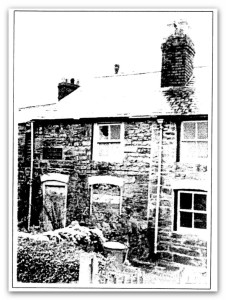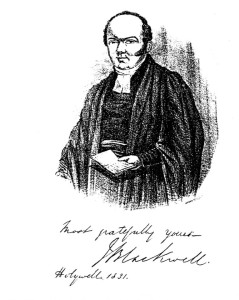by David Raymond Hughes
John Blackwell (Alun) of Mold has gained a place in the history of Welsh literature through his poetical works. His lyrical poems in the free metres are the forerunners of the lyrical poetry produced by the romantic movement in Wales in the nineteenth century.
Alun was born in Ponterwyl, Mold, in 1797, the son of Peter and Mary Blackwell. Both of his parents spoke Welsh and Mold was a thoroughly Welsh-speaking town at that time. His home at Ponterwyl was adjacent to the Calvinistic Methodist chapel in which he attended Sunday school as a boy. The house in which he lived was demolished in about 1970. The Calvinistic Methodists built a new chapel in New Street in 1819 and the site of the old chapel was eventually occupied by the Railway Inn (now also demolished).
The birthplace of John ‘Alun’ Blackwell at Ponterwyl, Mold., c 1970s.
At eleven years of age Alun became an apprentice shoemaker to William Kirkham, a Calvinistic Methodist who was interested in Welsh poetry. The young lad was much encouraged by Kirkham in his literary pursuits and he read extensively in both Welsh and English. He would borrow books from local antiquarians and also walk to Chester to purchase second hand volumes, especially from Mr. Swarbrick’s shop in Bridge Street.
As his literary knowledge increased he soon began to attend meetings of the Cymreigyddion societies and to compete in eisteddfodau. The Cymreigyddion societies were at that time established in many towns and villages in Wales.
These societies were not of a temperance nature as some met in public houses. They organized eisteddfodau and had an important place in the world of Welsh poetry at that time. They were the bardic schools of the period and provided the poets with an opportunity to learn about Welsh history. It was a chance for them to develop the art of public speaking and to meet influential people in the locality, included gentry, clergymen and other poets.
Alun was appointed Bard to the Ruthin Cymreigyddion Society in 1823. He won a prize for an awdl (ode) entitled ‘Ar Enedigaeth Iorwerth II yn Nghastell Caerynarfon’ (On the birth of Edward II in Caernarfon Castle), in an eisteddfod organized by this society in the same year.
An eisteddfod was also held in Mold in 1823 and Alun won the chair prize at this gathering for the best awdl on Maesgarmon, based on the traditional account of a battle said to have been fought near Rhual (c.429 AD) about one mile west of Mold.
Alun had been studying Welsh history, as stated earlier, and the two poems mentioned above are of a historical or antiquarian nature. Their weakness, as with other historical awdlau of the period, is that they tend to generalise about the past with not enough stress being placed upon specific historical facts. These odes were of course written in the strict metres.
His success at the Mold eisteddfod of 1823 brought Alun to the attention of the local gentry and he was highly complimented by Lord Mostyn who was president of this eisteddfod. After the activities were over a public dinner was held at the Leeswood Arms hotel. A number of the gentry were present and, in accordance with custom, the successful poets, harpists and singers were invited. Alun was asked to address the meeting and impressed the gathering. The dignitaries present held a meeting the following day with the object of finding a way to provide Alun with a formal education so that he could fulfil his desire of becoming a clergyman. To this end it was decided to raise a fund. Lord Mostyn (Sir Edward Price Lloyd. Bart.) subscribed £25 and a total of £220 in all was raised to provide Alun with formal education.
In January 1824 he went to the school of the Revd. Thomas Richards( 1785-1855) at Berriw in the old county of Montgomeryshire. Here he learnt Latin and Greek to prepare himself for entrance to university. He remained at Bernw until December of that year.
Thomas Richards was in touch with many literary Welshmen at this time and it was through him that Alun came into contact with the Revd. John Jenkins( 1770-1829), vicar of Ceri in Montgomeryshire, who greatly influenced his poetical style. Jenkins belonged to a school of poets which was in favour of reviving the use of the free metres in Welsh poetical works.
John Jenkins, or Ifor Ceri’ as he was known in bardic circles, was also a musicologist and antiquarian. He collected old airs and melodies. He built a new vicarage at Ceri and kept open house for his literary friends – including poets, singers and harpists. Alun was one of these friends who benefited from his patronage. He often visited the Revd. Jenkins and many of his poems are constructed so as to fit the tunes that he learnt at these literary gatherings.
Now more about his poetical works. Alun is best remembered for his poems in the free metres amongst which are : ‘Rhywun’ (Someone), ‘Cerdd Hela’ (Hunting Song), Cathl i’r Eos’ (Song to a Nightingale), ‘Can Gwraig y Pysgotwr’ (Song to the Fisherman’s Wife’), ‘Abaty Tintem’ (Tintern Abbey – an adaptation of an English poem except for the last four lines), and an elegy to Bishop Heber. He also translated some of the works of Pope and Heber into Welsh, with some being set to music. The following is the first verse of ‘Can Gwraig y Pysgotwr’,
Gorphwysdon! dylifa’n llonydd.
Paid a digio wrth y creigydd;
Y mae anian yn noswylio,
Pa’m y byddi di yn effro?
Dwndwrdaear sydd yn darfod,
Cysga dithau ar dy dywod.
The fisherman’s wife in this poem of five verses pleads to the sea to be kind and bring her husband safely home.
‘Rhywun’ (Somebody) is another of his acclaimed poems and it is possible that its theme was obtained from the work of Robert Burns, entitled ‘Somebody’. In the fifth verse Alun refers to the Bailey Hill in Mold and the river Alun :
Tra b’o clogwyn yn Eryri,
Tra b’o coed ar ben y Beili,
Tra b’odvvfr yn afon Alyn,
Cadwaf galon bur i RYWUN.
Loosely translated :
While there are cliffs in Snowdonia,
While there are trees on Bailey Hill,
While there is water in the river Alun,
I’ll keep a pure heart for SOMEONE.
A poem of local interest written by him is entitled ‘Cerdd Calan Gwyliedydd yr Wyddgrug’ (The New Year’s Day song of the Mold town crier). The town crier used to walk through the streets of Mold in the winter time, reporting on the state of the weather and on the time of day, so that workers knew when to get up for work. He was also concerned with the safety of the residents as he also used to be on the look out for thieves and burglars. On every New Year’s Day he would receive gifts as an acknowledgement of his services.
In December 1824 Alun left Berriw and the literary circle of Revd. John Jenkins and entered Jesus College, Oxford. During his time at the university he encountered, and was influenced by, the poetical works of the Revd. Reginald Heber and translated some of his hymns. Heber had connections with Flintshire since he married Amelia, daughter of Dr. Shipiey, Dean of St. Asaph. He became a prebendary of St. Asaph in 1812. (He composed ‘From Greenland’s Icy Mountains’ while on a visit to Wrexham Church). Eventually he became Bishop of Calcutta and died in India in 1826.
From Heber’s song entitled ‘Bow-meeting Song’, a song for Wales, Alun obtained the metres for his elegy to Bishop Heber which won him a prize at the Denbigh eisteddfod in 1828. Here is the first verse :
Lie treigla’r Caveri yn donau tryloywon,
Rhwng glenydd lie chwardd y pomgranad a’r pin,
Lie tyfa perlysiau yn llvvyni teleidion,
Lie distyll eu cangau y neithdar a’r gvvin;
Eistedda Hindoo ar lawr i alaru,
Ei ddagrau yn llif dros ei ruddiau melynddu,
A’i fron braidd rhy lawn i’w dafod lefaru,
Ymdorai ei alaeth fel hyn dros ei fin.
Alun graduated at Oxford in 1828 and became curate of Holywell in 1829. Here he stayed for four years doing much good work in the town. He was instrumental in establishing a clothing club for the distribution of clothes to the poor and for his efforts became known as ‘The poor man’s parson.’ He was also very active in helping the sick and needy during the cholera epidemic of 1832.
During his stay at Holywell, Alun met H. Bellenden Ker of Lincoln’s Inn, London., who at that time was a commissioner appointed to determine the boundaries of the Welsh boroughs in connection with the Reform Act of 1832. Ker was much impressed by Alun and brought him to the attention of the Lord Chancellor (Lord Brougham). This led Alun to promotion in the church and in 1833 he became rector of Maenordeifi in the old county of Pembrokeshire.
Before leaving Holywell, a public breakfast was arranged in order to show appreciation for his work in the town. He received a tea service as a token of gratitude. One of the salvers bore the following inscription :
A Tea Service.
Consisting of Tea Pot, Coffee Pot, Sugar ‘Basin and Cream ‘Ewer,
together with, this and a corresponding Salver
was presented to the Rev. John Blackwell, B.A
Curate of Holywell
‘By a number of his affectionate parishoners
Holywell, 26th February, 1833.
At Maenordeifi Alun was made editor of a periodical entitled Y Cylchgrawn which was published under the auspices of the S.P.C.K. (The Society for the Promotion of Christian Knowledge) for the eighteen months of its existence, 1834-5. In 1839 he married Matilda Dear of Pistyll (present day Springfield Hotel) near Holywell. He died on 19 May 1840 and was buried in Maenordeifi where a memorial tablet was placed on one of the walls of the church.
What better at this point than to mention an englyn he composed while in Mold Church cemetery.
Ond cael nod hynod, a hedd – yr lesu
A drws i dangnefedd
Yn dawel yn y diwedd,
Af i gaban bychan bedd.
To conclude, Alun’s verse in the strict metres is competent but inferior to his lyrical poems in the free metres. The eminent Welshman Owen M. Edwards stated in 1909, ‘Eos Cymru oedd Alun, yn felus a dwys yr erys ei nodau yng nghlust ei genedl.’ (He was the Nightingale of Wales, sweet and intense remain his notes to the ear of his nation).
Copyright of articles
published in Ystrad Alun lies with the Mold Civic Society and individual contributors.
Contents and opinions expressed therein
remains the responsibility of individual authors.

